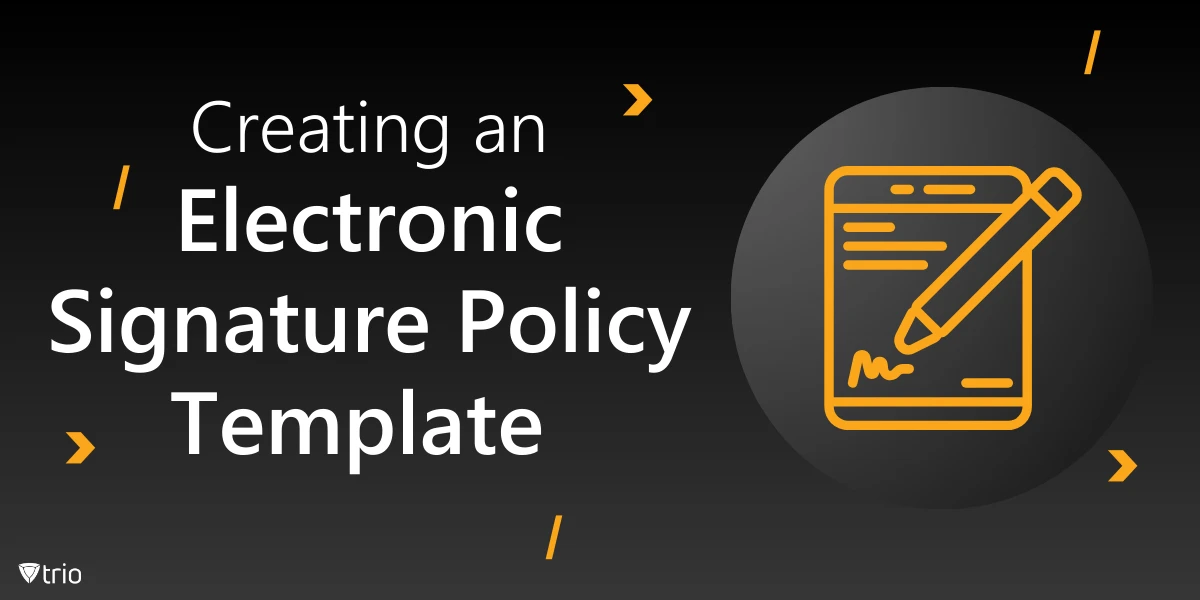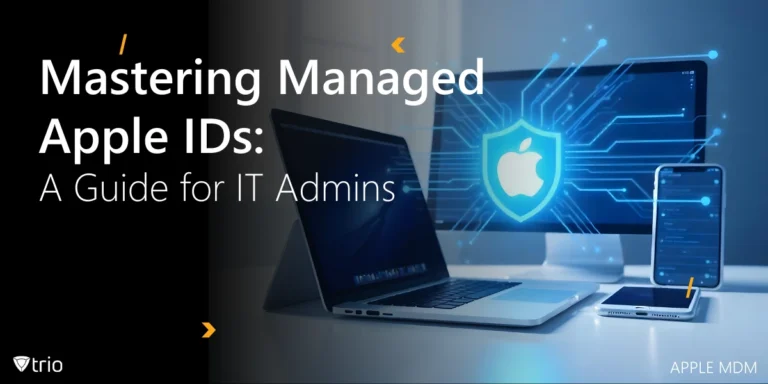In the digital age, businesses are shifting away from traditional paper-based processes to faster, more secure methods. One such advancement is the adoption of electronic signatures (e-signatures), a legally binding way to sign documents electronically. E-signatures not only offer convenience but also improve security, save time, and reduce operational costs. In fact, the global digital signature market is expected to reach $14.1 billion by 2026. Electronic signatures are increasingly becoming a staple in modern business practices, offering benefits across a wide range of industries.
This blog will explore the advantages of electronic signatures, who should use them, the policies surrounding their use in organizations, and how to create an effective electronic signature policy template.
What Are Electronic Signatures?
An electronic signature is a digital form of a traditional handwritten signature. It can be used to approve documents, contracts, forms, and agreements, allowing for quicker and more efficient workflows. Depending on the system used, an e-signature can range from typing a name into a form, using a stylus on a touchscreen device, or even leveraging advanced authentication methods like biometrics or digital certificates.
Electronic signatures are legally binding in many countries, provided they meet certain criteria. For example, in the European Union, the eIDAS Regulation sets out strict guidelines for electronic identification and trust services, including electronic signature requirements. In the United States, the ESIGN Act and UETA (Uniform Electronic Transactions Act) govern the use of e-signing a document, recognizing their validity and enforceability.
What Constitutes a Signature?
A signature is a mark, symbol, or action used by an individual to indicate their approval, intent, or consent to the terms of a document. In both physical and electronic contexts, the specific nature of a signature can vary, but here are some common characteristics that constitute a valid signature:
- Personal Mark or Symbol: Traditionally, a signature is a handwritten name or mark made by the individual. It can be a full name, initials, or a unique personal mark.
- Intent to Sign: A valid signature requires that the individual intends to sign the document and agrees to the terms. The act of signing demonstrates the person’s consent to be bound by the agreement or document.
- Identification of the Signatory: A signature serves as an identifier for the individual signing the document.
- Permanent or Non-Revocable Mark: Once a signature is affixed, it is intended to be permanent and should not be altered.
- Legal Acceptance: A signature is legally recognized when it fulfills the requirements of the applicable laws or regulations. This can vary by jurisdiction and the type of document being signed.
The Benefits of Using Electronic Signatures
The electronic signature of documents offers multiple benefits for businesses of all sizes, from startups to multinational corporations. Here’s how they can enhance your organization:
1- Increased Efficiency
Electronic signatures streamline business processes, removing the need to print, sign, scan, and mail documents. With e-signatures, the entire process can be completed online, reducing delays and speeding up decision-making. Contracts that used to take days or weeks to finalize can now be executed within minutes, helping businesses close deals faster.
2- Cost Savings
Traditional methods of signing documents involve printing, postage, storage, and manual handling—all of which cost time and money. By adopting electronic signatures, organizations can eliminate many of these costs. There’s no need to print multiple copies of a document, nor do you need to pay for postage or couriers. The time saved also translates into financial savings.
3- Enhanced Security
E-signatures often come with security features that make them more secure than traditional paper signatures. For example, many e-signature platforms use encryption, digital certificates, and multi-factor authentication to verify the identity of the signatory and ensure that the document has not been tampered with. These security measures provide an additional layer of protection against fraud and unauthorized access.
4- Legal Validity and Compliance
In many regions, electronic signatures are legally recognized and enforceable, provided they meet specific standards. Regulatory frameworks like eIDAS in the EU and the ESIGN Act in the U.S. ensure that e-signatures have the same legal standing as handwritten signatures. Additionally, many e-signature platforms offer audit trails, providing a detailed record of each step in the signing process, which can be used as evidence in case of disputes.
5- Environmental Sustainability
By eliminating the need for paper, ink, and physical transportation, electronic signatures contribute to a more environmentally sustainable business model. This helps reduce the organization’s carbon footprint and contributes to corporate social responsibility goals, which is increasingly important in today’s socially conscious business environment.
Who Should Use Electronic Signatures?
Given their versatility and security, e-signatures are useful across various sectors and industries. Here are some groups that can particularly benefit from using electronic signatures:
1- Legal and Contract Management
Lawyers and contract managers frequently handle large volumes of documents requiring signatures. E-signatures allow them to process legal agreements, contracts, and other documents faster and with greater security.
2- Sales and Business Development
Sales teams can use electronic signatures to accelerate deal closure by allowing clients to sign contracts digitally, even if they are halfway across the world. E-signatures can reduce sales cycles, allowing businesses to recognize revenue more quickly.
3- Human Resources (HR)
HR departments manage numerous documents that require signatures, from employment contracts to benefits forms and non-disclosure agreements. E-signatures help streamline these processes, making onboarding and other HR functions more efficient.
4- Finance and Procurement
Finance teams often deal with approval workflows that require signatures on invoices, purchase orders, and expense reports. E-signatures provide a quicker, more reliable way to manage these financial documents.
5- Healthcare
In the healthcare industry, time is of the essence, and electronic signatures can help streamline patient consent forms, prescriptions, and insurance documents while ensuring data security and compliance with regulations like HIPAA.

What Documents Cannot be Signed Electronically?
While electronic signatures (e-signatures) are widely accepted for many types of documents, there are certain cases where they may not be legally valid or recommended, depending on jurisdiction and industry regulations. Here are examples of documents that typically cannot be signed electronically:
- Wills and Testamentary Documents: Many countries require that wills and other testamentary documents be physically signed and witnessed in person to ensure the authenticity of the document and the signatory’s intent.
- Marriage and Divorce Papers: Legal documents related to marriage, divorce, and other family law matters often require physical signatures. This ensures the parties involved are physically present and fully aware of the legal implications.
- Court Orders and Legal Notices: Some court orders, notices, and pleadings need to be signed in person, especially those requiring the involvement of judges or court clerks, to avoid fraud and unauthorized filings.
- Notarized Documents: Documents requiring notarization, such as deeds, real estate transfers, and some contracts, generally cannot be signed electronically unless specifically allowed by local laws (e.g., remote notarization in certain jurisdictions).
- Powers of Attorney: Powers of attorney, especially those dealing with significant legal and financial authority, often need physical signatures to be valid. Many jurisdictions have stringent requirements for these documents to protect against misuse.
- Adoption Papers: Adoption papers, and documents related to parental rights, are usually excluded from electronic signature acceptance to ensure due diligence and legal oversight.
- Real Estate Transfers and Leases: Depending on the jurisdiction, deeds and some real estate contracts may not be valid with electronic signatures. This is especially true when the transfer of property involves a legal title change.
- Certain Government Filings: Some government agencies, especially those in international contexts, may require physical signatures for sensitive filings, such as tax filings in certain countries or immigration documents.

How to Create an Electronic Signature Policy Template for Your Organization
A well-structured electronic signature policy is crucial for maintaining compliance, security, and efficiency. Here’s a step-by-step guide to help you create an electronic signature policy template for your organization:
Step 1: Establish Purpose and Scope
Start by defining the purpose of the policy. Clearly outline why the organization is adopting electronic signatures and which types of documents will be included. For example:
- Contracts
- Agreements
- HR forms
- Financial approvals
This section should also specify any exceptions, such as documents that must still be signed using traditional methods due to legal or regulatory requirements.
Step 2: Specify Legal and Regulatory Compliance
In this section, detail the legal frameworks and regulations that the organization complies with when using electronic signatures. For instance, you might include references to the ESIGN Act, UETA, or eIDAS and explain how your e-signature practices adhere to these standards.
Step 3: Define Roles and Responsibilities
Outline the roles and responsibilities of employees involved in the e-signature process. Assign tasks such as managing user accounts, maintaining audit trails, ensuring the security of signed documents, and monitoring compliance with the policy.
Step 4: Establish Security Protocols
Your policy should include details on the security measures that will be employed to protect electronically signed documents. This could include encryption, user authentication, and secure storage protocols.
Step 5: Develop Audit and Retention Guidelines
Define how long documents with electronic signatures will be retained and how they will be stored. The policy should also mandate the creation of audit trails to document the entire signing process, from the moment the document is sent for signing to the final signature and storage.
Step 6: Implementation and Review
Explain how the policy will be rolled out across the organization and any training requirements for staff. Additionally, establish a schedule for reviewing and updating the policy to ensure it remains compliant with evolving regulations and business needs.
Free Electronic Signature Policy Template
Electronic signatures have become an essential tool for businesses looking to streamline processes, save costs, and improve security. By implementing a clear and comprehensive electronic signature policy, organizations can ensure compliance with legal frameworks and protect their data from potential security risks. Whether you are in legal, sales, HR, or finance, adopting e-signatures is a smart move towards a more efficient and secure future. You can check out our ready-made electronic signature policy template below.
See Trio in Action: Get Your Free Trial Now!
Looking for an efficient way to implement electronic signatures in your organization? Trio’s Mobile Device Management solution can help you manage and secure e-signature workflows. Request a free trial today and see how Trio can elevate your digital processes.




